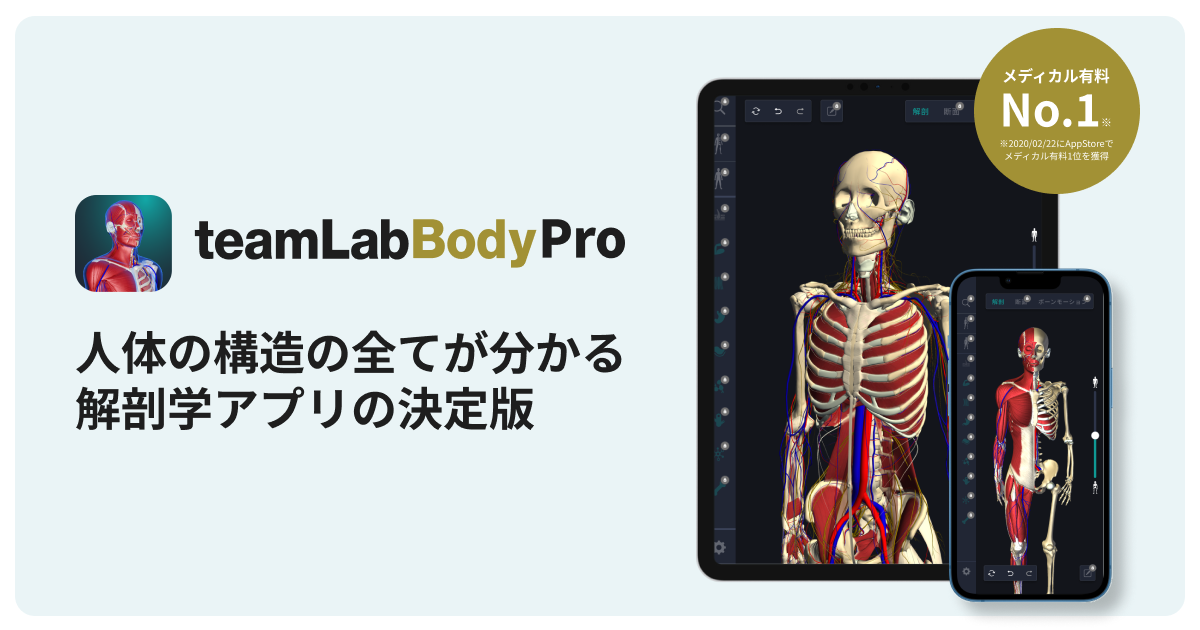beginning
In this article, I will explain the “posterior interosseous nerve” in detail. The posterior interosseous nerve is an important nerve that passes between the fingers and controls skin sensation and extensor muscles. In the case of a hand, it comes out from the radial side of the arm and conveys the space between the fingers. The posterior interosseous nerve can be remembered as “the nerve that controls the sensation between the fingers between the back bones” from the kanji, and is called Posterior Interosseous Nerve in English. Although dysfunction of the posterior interosseous nerves is relatively rare, sensory and movement disorders can be caused, and it is considered one of the important nerves for doctors.
Click here to watch a video about the posterior interosseous nerve (posterior interosseous nerve)
teamLab Body Pro Free Download
A 3D anatomy app that shows all the structures of the human body
Download teamLab Body Pro here!

What is the posterior interosseous nerve
The posterior interosseous nerve controls the back of the hand and is a nerve that transmits skin sensation in the hand. Also, it is an important nerve that is related to the movement of finger stretching and contraction, and also affects finger movement and muscle strength.
How to read posterior interosseous nerve
The posterior interosseous nerve is read as “kōkotsukan shinkei.” It is sometimes also called “posterior skeletal nerve” as an expression that was not common in the old days, but “posterior interosseous nerve” is a more accurate expression.
Characteristics of posterior interosseous nerves
The posterior interosseous nerve mainly passes between the fingers and supports extensor muscles and skin sensation. It plays a role in supporting finger movements by cooperating with various nerves.
Location/location of posterior interosseous nerves

If you look at the human body model diagram, in the case of a hand, the posterior interosseous nerve comes out from the radial side of the arm, divides between each finger, and conveys the sensation between the fingers.
How to remember the posterior interosseous nerve
As a trick to memorizing posterior interosseous nerves, it is easy to note that the posterior interosseous nerve is “posterior (back)” and that it is a nerve located “between bones (between bones),” and remember it as “the nerve that controls the space between the fingers between the back bones.” Also, if you keep in mind that it's a branch of the radial nerve, you'll definitely understand it.
English and Latin for posterior interosseous nerve
The posterior interosseous nerve is called the Posterior Interosseous Nerve in English and the Nervus Interosseus Posterior in Latin. By memorizing this name, you can easily access academic papers and materials in English-speaking countries.
Trivia about posterior interosseous nerves
Here's some trivia.
Posterior interosseous nerve dysfunction can cause decreased sensation between the fingers and movement disorders in each joint, etc., and is one of the important nerves for doctors. They can be damaged due to traffic accidents or injuries. Also, the posterior interosseous nerves are closely related to muscles and particularly affect hand finger movement and muscle strength. Functional impairment is relatively rare, but it can be seen that conscious and correct surgical techniques and wrist care are important.
Posterior interosseous nerve quiz and correct answers
Q: Where is the posterior interosseous nerve located and what is its role?
A: The posterior interosseous nerve controls the back of the hand and transmits skin sensation between the fingers. It also supports finger stretching.
Q: What symptoms can be considered when the posterior interosseous nerves are impaired?
A: There is a possibility that it may cause decreased sensation between the fingers and movement disorders in each joint. Also, it is conceivable that loss of muscle strength and finger movement will also be affected.
summary
This time, I explained the location and location of the “posterior interosseous nerve”, how to memorize it, and the English/Latin notation.
How was it?
I would be happy if reading this article deepened my understanding of anatomy.
Learning is a long, never-ending journey, but I sincerely wish you all the best. Let's continue to study together and work hard for the national exam!
Please look forward to the next blog.
Learn more with the anatomy app “TeamLabBody Pro”!
teamLabBody Pro is a “3D human anatomy application” that covers the entire body of the human body, including muscles, organs, nerves, bones and joints.
The human body is faithfully reproduced from CT and MRI data based on data from multiple subjects. Since medical book-level content supervised by physicians can be freely viewed from all angles, it can be used for various medical situations, such as explaining surgery to patients and studying anatomy for students.
If you want to see the parts introduced this time in more detail, please download the anatomy application “teamLabBody Pro.”
■teamLab Body Pro Free Download





